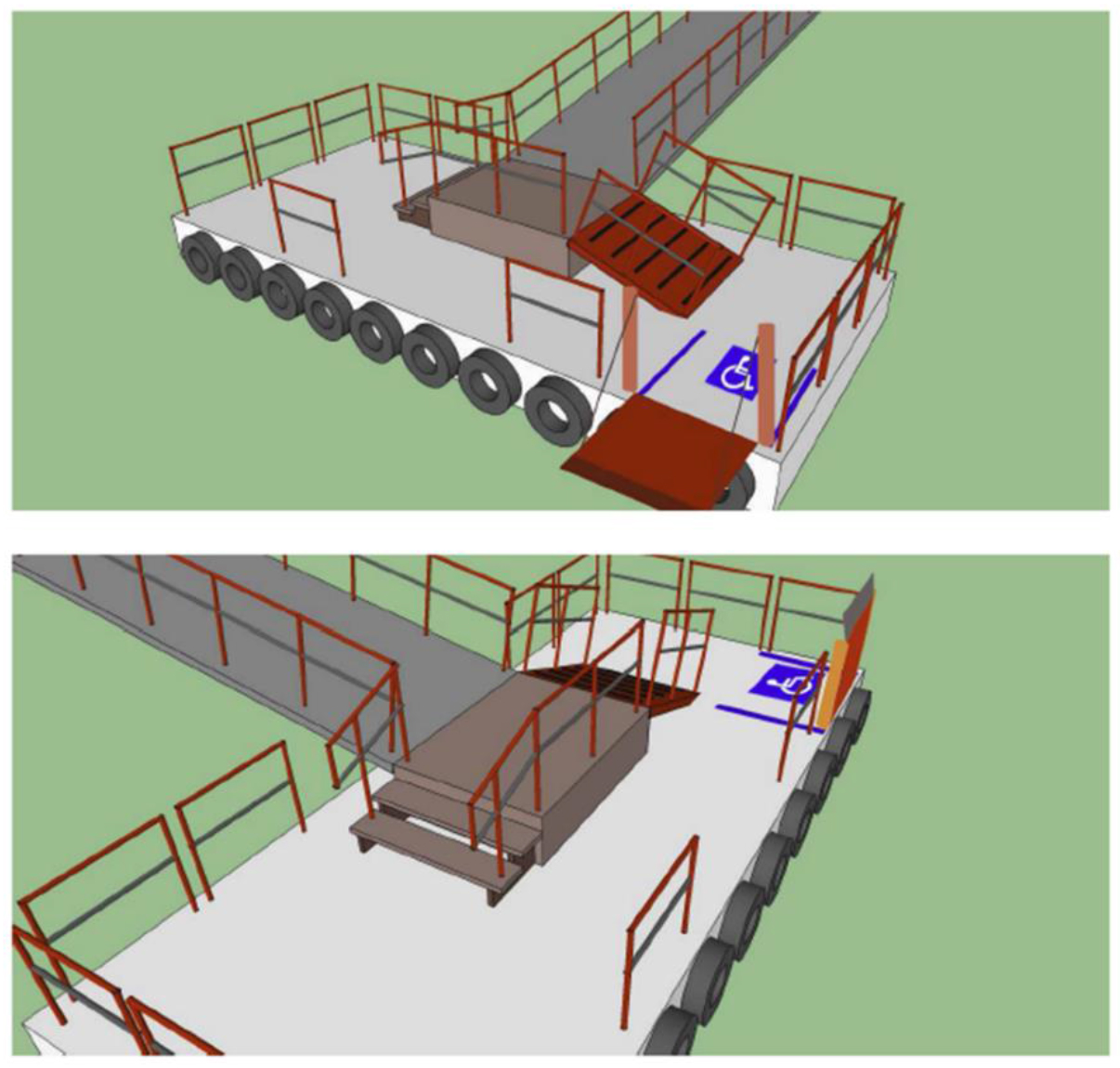Universal Design Guidelines for Pontoon Pier : Moo-7 Pier (Kru Tew Pier),Ko Kret Island and Pak Kret Pier, Nonthaburi
Main Article Content
Abstract
Objectives of this research are 1) to study the current conditions of pontoons for traveling from Moo-7 Pier (Kru Tew Pier) to Pak Kret Pier 2) to analyze and improve the pontoons and 3) to propose pontoon for all design guidelines. The data collection tools include surveys of the physical condition of the pontoons and structured interviews of passenger satisfaction of the conditions. The data and information were obtained by observation, surveying, and interview. Nine participants who live on Ko Kret Island, which include those with the elderly who depend on themselves and need help, persons with physical disability and wheelchair users.The result was found that at Moo-7 Pier and Pak Kret Pier, showed the difference between the lower end of the gangway and the pontoon levels and the difference between the pontoon and the boat levels. The guardrails were installed only partially. There were none of the boarding assistance zone for disabled or wheelchair people. Most of the participants did not feel that the pontoons’ physical conditions were hindering them from travelling as they were used to it. However, they agreed that the conditions should be improved. Therefore, as a design guideline, the pontoons for all should be made both piers. The connection between the lower end of the gangway and the pontoon should install ramp, landing and stairs. The connection between the pontoon and the boat should install a foldable boarding ramp. The gangway should be adjusted to a proper slope, and equipped with handrails on both sides. Guardrails should be installed around the pontoons completely. Boarding assistance zone should be allocated with the boarding assistance sign or international symbol of access which should be painted on the pontoon platform. In addition, a large signage of pier for all should also be put up to see clearly.
Downloads
Article Details

This work is licensed under a Creative Commons Attribution-NonCommercial-NoDerivatives 4.0 International License.
All material is licensed under the terms of the Creative Commons Attribution 4.0 International (CC-BY-NC-ND 4.0) License, unless otherwise stated. As such, authors are free to share, copy, and redistribute the material in any medium or format. The authors must give appropriate credit, provide a link to the license, and indicate if changes were made. The authors may do so in any reasonable manner, but not in any way that suggests the licensor endorses you or your use. The authors may not use the material for commercial purposes. If the authors remix, transform, or build upon the material, they may not distribute the modified material, unless permission is obtained from JARS. Final, accepted versions of the paper may be posted on third party repositories, provided appropriate acknowledgement to the original source is clearly noted.
References
Aghaabbasi, M., Moeinaddini, M., Asadi-Shekari, Z., & Shah, M. Z. (2019). The equitable use concept in sidewalk design. Cities, 88, 181-190.
Association of Siamese Architects Under Royal Patronage. (2009). Universal design code of practice. Bangkok,Thailand: Plus Press.
Baer, B., Bhushan, A., Taleb, H. A., Vasquez, J., & Thomas, R. (2016). The right of health of older people. The Gerontologist, 56, S206-S217.
Center for Universal Design. (1997). The principles of universal design. Version 2.0 – 4/1/97. North Carolina: North Carolina State University.
Community for Coexistence and Accessibility in ASEAN: Ko Kret Community Prototype Project, Nonthaburi Province. (2015). A study report on environment and basic facilities for the disabled and the elderly to travel from the area of Pak Kret municipality across to Ko Kret & A satisfaction survey and recommendations for facilities for the disabled and the elderly in the study area. Bangkok, Thailand: An Appropriate Environment for Elderly and Disabled people Research Unit, Chulalongkorn University.
Egan, J. (2004). The Egan review: Skills for sustainable communities. London: The Office of the Deputy Prime Minister.
Jarutach, T. (2015). Universal design guide book. Bangkok, Thailand: Faculty of Architecture, Chulalongkorn University.
JS 100. (2019, May 25). Many good citizens jumped into the water to help the elderly woman whom fell into the canal at The Mall Bangkapi pier. Retrieved May 26, 2019, from http://www.js100.com/en/site/news/view/72763.
Kadir, S. A., & Jamaludin, M. (2013). Universal design as a significant component for sustainable life andsocial development. Procedia-Social and Behavioral Sciences, 85, 179-190.
Kohkred Subdistrict Administrative Organization. (2014)
Manley, S. (2010). Creating an accessible public realm. In W. F. E. Preiser & K. H. Smith (Eds.), Universal design handbook (2 ed.). New York: McGraw-Hill.
National Committee on the Elderly. (2010). The 2nd National plan on the eldery (2002-2021) 1st Revised of 2009. Bangkok, Thailand: Department of Older Persons, Ministry of Social Development and Human Security Thailand.
National Committee on the Empowerment of Persons with Disabilities. (n.d.). The 4th National plan on the empowerment of persons with disabilities (2012-2016). Bangkok, Thailand: Department of Empowerment of Persons with Disabilities, Ministry of Social Development and Human Security Thailand.
Royal Thai Government Gazette. (1994). Ministerial Regulation No. 63 B.E. 2537 (1994) Issued by Navigation in the Thai Waters Act B.E. 2456 (1913). Retrieved July 18, 2019, from http://www.ratchakitcha.soc.go.th/DATA/PDF/2537/A/036/52.PDF.
Royal Thai Government Gazette. (2007). Empowerment of Persons with Disabilities Act, B.E. 2550 (2007). Retrieved July 18, 2019, from http://www.ratchakitcha.soc.go.th/DATA/PDF/2550/A/061/8.PDF.
Siriwong, P., & Sengdaeng, P. (2011). The traveling of physically disabled in Thailand. Veridian E-Journal Silpakorn University: Humanities, Social Sciences, and Arts, 4(2), 221-228.
Steinfeld, E. (2010). Universal design in mass transportation. In W. F. E. Preiser & K. H. Smith (Eds.), Universal Design Handbook (2 ed.). New York: McGraw-Hill.
Thairath Online. (2015, February 24). Flashback 20 years capsized boat tragedy EP. 2: Prannok pier, Will the past that never be forgotten already give the lessons to society?. Retrieved May 26, 2019, from https://www.thairath.co.th/news/local/482720.
Zajac, A. P. (2016). City accessible for everyone – Improving accessibility of public transport using the universal design concept. Transportation Research Procedia, 14, 1270-1276.


